|
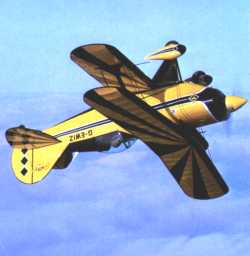 One
of only two examples of the S-2S in the UK, this aircraft was built
by Hilton Selvey in Darwin, Australia from a factory kit in 1981
and was registered VH-EHQ serial number S18. The aircraft was shipped
to Frankfurt in 1982 to take part in the World Aerobatic Championships
held in Austria that year. The aircraft was flown by Geoff Selvey,
Hilton's son, who came 29th out of a field of 65 competitors. Oddly
enough, the idea was to sell the aeroplane after the competition
as the team had done in 1980. One
of only two examples of the S-2S in the UK, this aircraft was built
by Hilton Selvey in Darwin, Australia from a factory kit in 1981
and was registered VH-EHQ serial number S18. The aircraft was shipped
to Frankfurt in 1982 to take part in the World Aerobatic Championships
held in Austria that year. The aircraft was flown by Geoff Selvey,
Hilton's son, who came 29th out of a field of 65 competitors. Oddly
enough, the idea was to sell the aeroplane after the competition
as the team had done in 1980.
With less than 100 hours total time since new, the aeroplane was
imported to the UK by Geoff Masterton, re-registered G-EWIZ and
issued with a CAA permit to fly in November 1982. The original yellow
and black colour scheme was replaced by bottle green following sponsorship
from the off-licence chain Bottoms Up. It was displayed in this
livery by the late John Davies before being privately owned and
flown very little from it's base at Bournemouth.
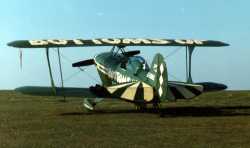 Advertised
for sale in mid 1996 and having flown only 337 hours since new,
G-EWIZ was bought by Steve Carver and David Howdle. The aircraft
looked rather tatty but, under the guidance of Rob Millinship, was
soon shown to be an excellent purchase. The aircraft was based at
Netherthorpe airfield and flown until the winter of 1996/1997 during
which time it was it was placed on the PFA register. With Rob's
help over a six-month period, G-EWIZ was recovered and considerably
improved, re-emerging in a bright red and white scheme. The addition
of some red/white chequerboard to the rudder and under the outer
wing panels helped to provide a finishing touch. A smoke system
was added two years later and the aircraft has been flown successfully
by Steve Carver at displays and Intermediate level competitions
during the 2000 season. Steve is now the sole owner. Advertised
for sale in mid 1996 and having flown only 337 hours since new,
G-EWIZ was bought by Steve Carver and David Howdle. The aircraft
looked rather tatty but, under the guidance of Rob Millinship, was
soon shown to be an excellent purchase. The aircraft was based at
Netherthorpe airfield and flown until the winter of 1996/1997 during
which time it was it was placed on the PFA register. With Rob's
help over a six-month period, G-EWIZ was recovered and considerably
improved, re-emerging in a bright red and white scheme. The addition
of some red/white chequerboard to the rudder and under the outer
wing panels helped to provide a finishing touch. A smoke system
was added two years later and the aircraft has been flown successfully
by Steve Carver at displays and Intermediate level competitions
during the 2000 season. Steve is now the sole owner.
G-EWIZ will be flown at Advanced level competitions during 2003
and has become familiar again to airshow enthusiasts throughout
the UK. If you would like to book Steve and G-EWIZ for an aerobatic
display or sponsor the aircraft for the 2003/4 seasons then e-mail
Steve at gewiz@stevecarver.f9.co.uk.
|






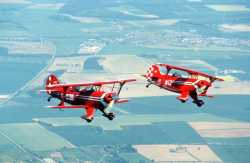 By
1969 Curtis Pitts had set up production in Afton Wyoming. Factory
aircraft such as the S2S and S2B are only slightly larger but about
twice the weight of the original S1; by the early 1980's though, power
had been increased to a massive 260hp. The wings were now symmetrical,
with four ailerons, and looking back it would be quite easy to imagine
a train of development that from the outset had in mind the factory
aircraft of today - a point that is worthy of some debate when looking
through this remarkable chronology. If you are interested in the development
of this classic aircraft, then have a look at Bud Davidson's book
"Pitts Specials" (very rare - if you find a copy, hang on
to it!), or "Why a Pitts is Something Special" by James
Gilbert and Mike Jeram in Pilot Magazine, June 1988.
By
1969 Curtis Pitts had set up production in Afton Wyoming. Factory
aircraft such as the S2S and S2B are only slightly larger but about
twice the weight of the original S1; by the early 1980's though, power
had been increased to a massive 260hp. The wings were now symmetrical,
with four ailerons, and looking back it would be quite easy to imagine
a train of development that from the outset had in mind the factory
aircraft of today - a point that is worthy of some debate when looking
through this remarkable chronology. If you are interested in the development
of this classic aircraft, then have a look at Bud Davidson's book
"Pitts Specials" (very rare - if you find a copy, hang on
to it!), or "Why a Pitts is Something Special" by James
Gilbert and Mike Jeram in Pilot Magazine, June 1988.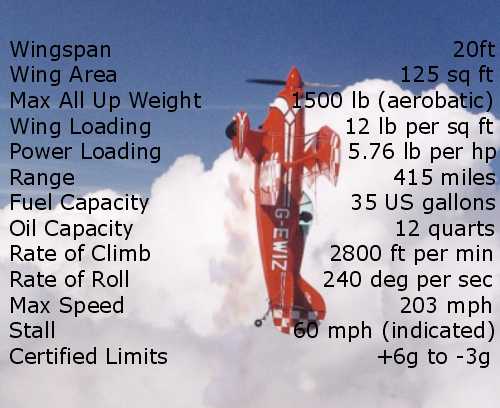











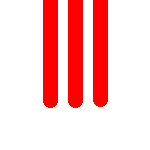

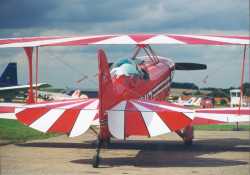 America
in the 1940's; airshow audiences were thrilled and entertained by
aerobatic routines flown in aircraft such as the Great Lakes, the
Jungmeister, Waco, Curtiss and Boeing. Curtis Pitts, so the history
goes, wanted to operate a small, cheaper aircraft and in 1942 began
the development of what soon became known as the Pitts Special.
In direct contrast the little biplane weighed in at around 500 lbs
and first flew in 1945, powered by a 55hp Lycoming engine, however
this was soon to be replaced by an engine of 90hp.
America
in the 1940's; airshow audiences were thrilled and entertained by
aerobatic routines flown in aircraft such as the Great Lakes, the
Jungmeister, Waco, Curtiss and Boeing. Curtis Pitts, so the history
goes, wanted to operate a small, cheaper aircraft and in 1942 began
the development of what soon became known as the Pitts Special.
In direct contrast the little biplane weighed in at around 500 lbs
and first flew in 1945, powered by a 55hp Lycoming engine, however
this was soon to be replaced by an engine of 90hp.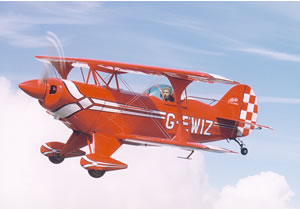 The
Pitts S2S first flew in December 1977 and was certified in June
1981; there are around thirty world wide, of which two currently
reside in the UK. It is a single seat unlimited aerobatic aeroplane
of two seat proportions.
The
Pitts S2S first flew in December 1977 and was certified in June
1981; there are around thirty world wide, of which two currently
reside in the UK. It is a single seat unlimited aerobatic aeroplane
of two seat proportions. One
of only two examples of the S-2S in the UK, this aircraft was built
by Hilton Selvey in Darwin, Australia from a factory kit in 1981
and was registered VH-EHQ serial number S18. The aircraft was shipped
to Frankfurt in 1982 to take part in the World Aerobatic Championships
held in Austria that year. The aircraft was flown by Geoff Selvey,
Hilton's son, who came 29th out of a field of 65 competitors. Oddly
enough, the idea was to sell the aeroplane after the competition
as the team had done in 1980.
One
of only two examples of the S-2S in the UK, this aircraft was built
by Hilton Selvey in Darwin, Australia from a factory kit in 1981
and was registered VH-EHQ serial number S18. The aircraft was shipped
to Frankfurt in 1982 to take part in the World Aerobatic Championships
held in Austria that year. The aircraft was flown by Geoff Selvey,
Hilton's son, who came 29th out of a field of 65 competitors. Oddly
enough, the idea was to sell the aeroplane after the competition
as the team had done in 1980. Advertised
for sale in mid 1996 and having flown only 337 hours since new,
G-EWIZ was bought by Steve Carver and David Howdle. The aircraft
looked rather tatty but, under the guidance of Rob Millinship, was
soon shown to be an excellent purchase. The aircraft was based at
Netherthorpe airfield and flown until the winter of 1996/1997 during
which time it was it was placed on the PFA register. With Rob's
help over a six-month period, G-EWIZ was recovered and considerably
improved, re-emerging in a bright red and white scheme. The addition
of some red/white chequerboard to the rudder and under the outer
wing panels helped to provide a finishing touch. A smoke system
was added two years later and the aircraft has been flown successfully
by Steve Carver at displays and Intermediate level competitions
during the 2000 season. Steve is now the sole owner.
Advertised
for sale in mid 1996 and having flown only 337 hours since new,
G-EWIZ was bought by Steve Carver and David Howdle. The aircraft
looked rather tatty but, under the guidance of Rob Millinship, was
soon shown to be an excellent purchase. The aircraft was based at
Netherthorpe airfield and flown until the winter of 1996/1997 during
which time it was it was placed on the PFA register. With Rob's
help over a six-month period, G-EWIZ was recovered and considerably
improved, re-emerging in a bright red and white scheme. The addition
of some red/white chequerboard to the rudder and under the outer
wing panels helped to provide a finishing touch. A smoke system
was added two years later and the aircraft has been flown successfully
by Steve Carver at displays and Intermediate level competitions
during the 2000 season. Steve is now the sole owner.